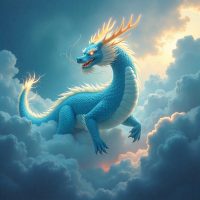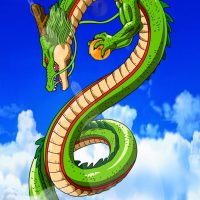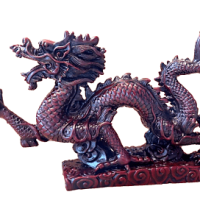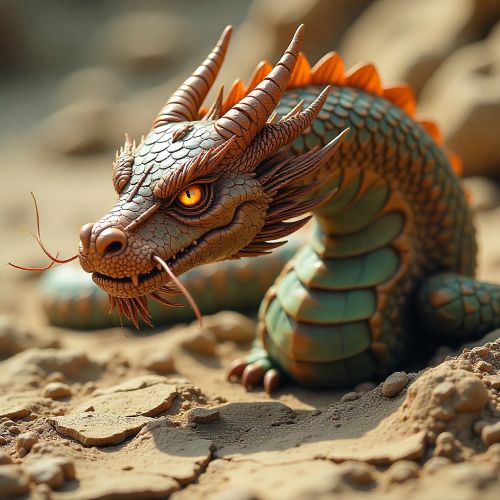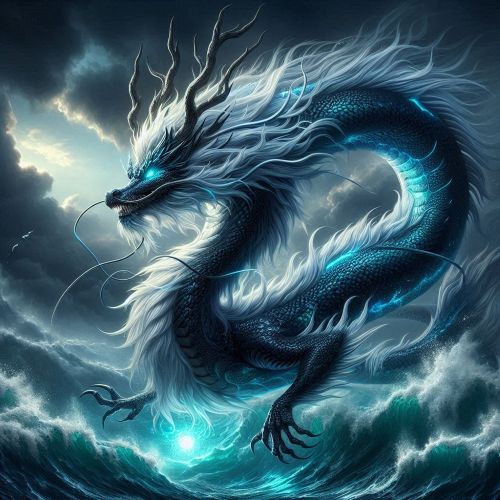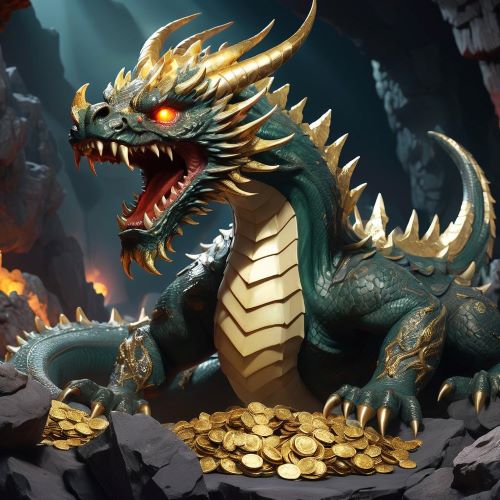Shenlong : The Chinese Divine Dragon of Rain and Storms
Listen
At a glance
| Description | |
|---|---|
| Origin | Chinese Mythology |
| Classification | Animals |
| Family Members | N/A |
| Region | China |
| Associated With | Rain |
Shenlong
Introduction
Shenlong, often translated as “Divine Dragon” or “Spirit Dragon,” is one of the most revered celestial beings in Chinese mythology. Known as the master of storms, rain, and the movement of the skies, Shenlong occupies a central place in the ancient world’s understanding of natural balance. For centuries, farmers, rulers, and entire communities looked to him to ensure fertile soil, predictable seasons, and protection from catastrophic droughts. Unlike the destructive dragons seen in Western folklore, Shenlong symbolizes life, harmony, and the cyclical rhythm of nature. His power to summon rain made him indispensable in an agrarian society, while his majesty established him as a symbol of imperial authority and cosmic order. Through myth, art, ritual, and literature, Shenlong emerged as a divine presence that connected heaven and earth, guiding humanity’s relationship with nature and its forces.
Physical Traits
Shenlong is traditionally portrayed as a long, serpentine dragon whose appearance reflects his celestial purpose. His scales are often described as shimmering blue or green, mirroring the hues of the sky and the flowing currents of rivers and clouds. This coloration emphasizes his connection to weather and the atmosphere. Shenlong possesses four strong legs ending in sharp talons, each claw signalling great authority—five claws in imperial depictions, aligning him with the Emperors of China who used the dragon as a symbol of their mandate.
Unlike his Western counterparts, Shenlong does not require wings to fly. His movement through the sky is entirely divine, allowing him to glide silently through clouds and mist. His head is adorned with antler-like horns, long whiskers, a flowing mane, and a fierce yet dignified expression that blends wisdom with overwhelming power. Art from various dynasties often shows him coiled amidst swirling vapors, suggesting his constant vigilance over storms and rainfall. The pearl frequently shown beneath his chin symbolizes his role in controlling the elements and maintaining natural balance.
Family
Unlike some mythological beings with clearly defined families, Shenlong’s lineage is more conceptual than literal. He is understood as part of the broader category of long—Chinese dragons who govern different cosmic roles. Within this classification, Shenlong stands alongside Tianlong, the celestial guardian; Qinglong, the eastern directional deity; Yinglong, the river-associated dragon; and Zhulong, the dragon linked to cosmic illumination and time. These dragons collectively represent the multifaceted forces shaping the universe.
While Shenlong himself is not described as having a direct spouse or children in classical texts, later folk traditions sometimes attribute multiple sons to Chinese dragons in general. These sons represent symbolic aspects of culture, architecture, and ritual, though their identities vary widely across regions. Shenlong’s place within this symbolic family reinforces his role as a divine figure that contributes to cosmic order rather than following a traditional mythic genealogy.
Other names
Over the centuries, Shenlong has been known by several names depending on context, culture, and region. “Shenlong” directly translates to “Divine Dragon,” emphasizing his godlike nature. When described in relation to weather, he is sometimes called the Rain Dragon, highlighting his responsibility for storms and seasonal cycles. In some Chinese traditions, he is grouped with the Dragon Kings, known as Longwang, although Shenlong is typically viewed as a more celestial, sky-bound figure than the water-ruling kings.
In Japanese mythology, he appears as Shinryū, the spiritual dragon adapted from the Chinese deity. This cross-cultural presence shows the widespread influence of Shenlong’s image and the universal appeal of his elemental power. No matter the regional translation, each name reinforces his status as a divine force governing the natural world.
Powers and Abilities
Shenlong’s abilities revolve around absolute control over atmospheric and meteorological forces. He commands rain, wind, thunder, and lightning, determining whether seasons become fertile or barren. This dominion made him central to ancient rituals in which communities prayed for rains or attempted to appease the dragon during long droughts. His influence extended beyond agriculture; storms, floods, and tempests were interpreted as signs of his displeasure or warnings of imbalance.
He is also believed to possess profound wisdom, capable of understanding the cosmic flow of qi—the life energy that moves through every living landscape. Shenlong can expand or contract his size at will, vanish into clouds, travel between realms, and influence the harmony between heaven and earth. The mystical pearl often associated with him is thought to channel his elemental power, enabling him to control natural cycles with precision.
Modern Day Influence
Despite being rooted in ancient mythology, Shenlong’s presence remains deeply woven into contemporary Chinese culture. Dragon dances performed during Chinese New Year and harvest festivals symbolically represent Shenlong’s blessing, with the rhythmic movements mimicking the dragon’s motion across the sky to bring prosperity and good fortune.
Shenlong’s motif continues to appear in art, architecture, fashion, and literature, often symbolizing success, vitality, and noble authority. In modern entertainment, his influence extends globally. One of the most recognizable adaptations is Shenron from the Dragon Ball franchise, a wish-granting dragon inspired by Shenlong’s divine grandeur. Video games, anime, novels, and films draw upon his celestial image, reinforcing the dragon’s timeless appeal.
In rural storytelling and agricultural traditions, Shenlong remains a metaphor for humanity’s reliance on nature’s unpredictable gifts. His legacy persists not merely as a mythological figure, but as a cultural emblem representing the eternal dance between humans and the natural world.
Related Images
Source
Birrell, A. (1999). Chinese Mythology: An Introduction. Baltimore: Johns Hopkins University Press.
Wikipedia. (2003). Shenlong. Retrieved from https://en.wikipedia.org/wiki/Shenlong
Gods and Monsters. (2024). Shenlong. Retrieved from https://godsandmonsters.info/shenlong/
StorytellingDB. (n.d.). Shenlong: The Spiritual Chinese Dragon. Retrieved from https://storytellingdb.com/shenlong/
Mythopedia. (2022). Shennong. Retrieved from https://mythopedia.com/topics/shennong/
Gods and Demons Wiki. (2007). Shenlong. Retrieved from https://gods-and-demons.fandom.com/wiki/Shenlong
AnyofChina. (2025, July 23). 17 Types of Chinese Dragons in Mythology (with names). Retrieved November 24, 2025, from https://anyofchina.com/types-of-chinese-dragons/
Wu, C. (2024, October 24). The Legendary Shenlong: The Dragon of Rain and Agriculture. Chinese
Mythology Worldwide. Retrieved November 24, 2025, from https://chinese.mythologyworldwide.com/the-legendary-shenlong-the-dragon-of-rain-and-agriculture/
Birrell, A. (1993). Chinese Mythology: An Introduction. Baltimore: Johns Hopkins University Press.
Eberhard, W. (2003). A Dictionary of Chinese Symbols: Hidden Symbols in Chinese Life and Thought. London: Routledge.
Yang, L., & An, D. (2005). Handbook of Chinese Mythology. Oxford: Oxford University Press.
Littleton, C. S. (2002). Gods, Demons and Symbols of Ancient China. San Francisco: HarperCollins.
Loewe, M., & Black, M. (1993). Divination, Mythology and Monarchy in Han China. Cambridge: Cambridge University Press.
Frequently Asked Questions
Who is Shenlong in Chinese mythology?
Shenlong is the celestial dragon responsible for rain, storms, and atmospheric balance, revered for sustaining agricultural prosperity.
Why is Shenlong associated with rain?
As the divine controller of weather, Shenlong governs rainfall and seasonal cycles, making him central to ancient Chinese farming rituals.
Does Shenlong have wings?
No, Shenlong does not require wings. His divine nature allows him to fly through the sky effortlessly without them.
How is Shenlong different from the Dragon Kings?
Shenlong is a heavenly dragon of the skies, while the Dragon Kings rule oceans and rivers. Shenlong’s role focuses on weather and celestial forces.
Is Shenlong the inspiration for Shenron in Dragon Ball?
Yes, the wish-granting dragon Shenron was inspired by Shenlong, adapting his majestic form and divine presence for modern storytelling.


